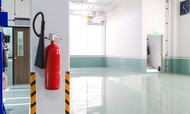Epoxy flooring has emerged as a popular choice for both residential and commercial spaces, offering durability, versatility, and aesthetic appeal. However, achieving the desired results with epoxy flooring requires careful planning, precise execution, and diligent maintenance. In this comprehensive guide, we'll delve into the dos and don'ts of epoxy flooring to ensure a successful installation and long-term maintenance plan.
Dos for Installation:
Remember!
The application of Epoxy must be done after reading the manufacturer instructions. All epoxy products are equipped to have manufacturer’s instructions and must be complied by. However general instructions and do’s are mention for DIY person.
1: Thorough Surface Preparation
Proper surface preparation is paramount for the success of an epoxy flooring installation. Begin by thoroughly cleaning the substrate to remove dirt, oil, grease, and any existing coatings. Use appropriate cleaning agents and techniques to ensure a pristine surface for optimal adhesion.
2: Conduct Moisture Testing
Moisture can wreak havoc on epoxy flooring, leading to issues such as delamination and bubbling. Before proceeding with installation, conduct moisture tests on concrete substrates to assess moisture levels. Address any excessive moisture issues before applying the epoxy to prevent future problems.
3: Apply Primer
Applying a high-quality primer is essential for enhancing adhesion and ensuring uniform coverage of the epoxy coating. Choose a primer that is compatible with both the substrate and the epoxy resin to promote strong bonding and long-lasting results.
4: Follow Mixing Ratios
Properly mixing epoxy resin and hardener in the correct ratios is crucial for achieving optimal curing and durability. Carefully measure and mix the components according to the manufacturer's instructions to avoid issues such as soft spots, tackiness, or incomplete curing.
5: Ensure Proper Ventilation
Adequate ventilation is necessary during the epoxy flooring installation process to facilitate proper curing and prevent air bubbles or solvent entrapment. Ensure sufficient airflow by opening windows, using fans, or employing mechanical ventilation systems as needed.
Don'ts for Installation:
Remember!
Always follow the caution section of instruction on the product. All manufacturers of Epoxy products have caution section indicating don’t for their product.
Keep the children away from the reach of Epoxy and application must be applied in the company of professional service. General caution and don’t of epoxy product for flooring are mentioned below for DIY people.
1: Neglecting Surface Preparation
Skipping or inadequately performing surface preparation can compromise the adhesion and longevity of the epoxy flooring. Avoid the temptation to cut corners and invest the necessary time and effort in preparing the substrate properly for optimal results.
2: Ignoring Moisture Issues
Ignoring moisture issues in concrete substrates can lead to significant problems down the line, including delamination, bubbling, and mold growth. Address any moisture problems through appropriate remediation measures before proceeding with epoxy installation.
3: Rushing the Process
Rushing through the epoxy flooring installation process can result in errors, uneven coverage, and subpar results. Take the time to follow each step carefully, from surface preparation to mixing and application, to ensure a flawless finish that meets your expectations.
4: Incorrect Mixing
Improperly mixing epoxy resin and hardener can compromise the chemical reaction necessary for curing, leading to weak spots or failure of the coating. Avoid guesswork and carefully follow the manufacturer's instructions for accurate mixing ratios and techniques.
5: Poor Ventilation
Inadequate ventilation during epoxy installation can prolong curing times, trap solvents, and result in an uneven finish. Ensure proper airflow and ventilation in the workspace to promote optimal curing and achieve the desired results.
Benefits of Following Epoxy Flooring Dos and Don'ts:
- Durability: Proper surface preparation, moisture testing, and correct mixing ensure a durable, long-lasting epoxy floor that can withstand heavy use without cracking or peeling.
- Increased Adhesion: Thorough cleaning and applying the right primer improve the bonding between the substrate and epoxy, ensuring the coating adheres strongly and remains intact for years.
- Uniform Finish: Following manufacturer instructions for mixing ratios and proper ventilation prevents bubbles, uneven textures, and tackiness, delivering a smooth, flawless finish.
- Moisture Protection: Conducting moisture tests and addressing issues beforehand prevents problems like delamination, bubbling, and mold growth, ensuring the floor stays intact even in high-humidity areas.
- Optimal Aesthetic Appeal: Taking the time to follow correct application procedures ensures the epoxy coating retains its vibrant color and sheen, enhancing the visual appeal of your space.
- Time and Cost Efficiency: Avoiding common mistakes like rushing the process or skipping steps reduces the chances of needing repairs, saving both time and money in the long run.
- Safety Compliance: Proper ventilation and caution during installation help in preventing health risks associated with solvent fumes and ensuring a safer environment during and after application.
- Low Maintenance: Adhering to installation guidelines ensures a resilient surface that requires minimal maintenance, reducing cleaning efforts and costs over time.
- Long-Term Value: Well-installed epoxy flooring increases the overall value of your property by providing a durable, attractive, and low-maintenance surface ideal for both residential and commercial use.
Mastering the dos and don'ts of epoxy flooring installation and maintenance is essential for achieving beautiful, long-lasting results. By following these guidelines and best practices, you can ensure a successful epoxy flooring project that enhances the aesthetics, durability, and value of your space for years to come.

